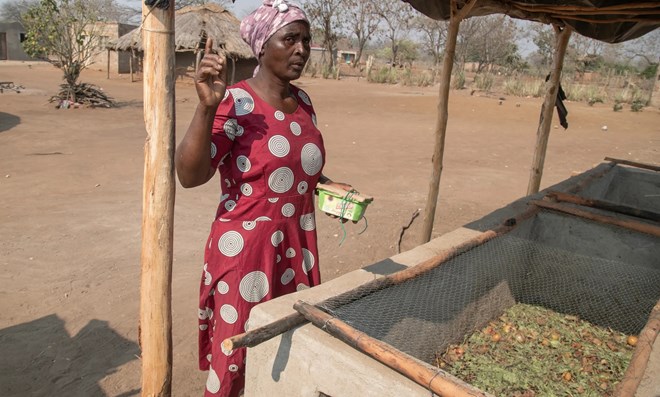
Sunday December 1, 2024

Maggot breeder, Chemari Choumumba stands next to a production tank of maggots at her home in Chiredzi, Zimbabwe Wednesday, Sept. 18, 2024. (AP Photo/Aaron Ufumeli)
Mogadishu (HOL) — At dawn, as the sky blushes pink over Nyangambe’s parched fields, Mari Choumumba strides purposefully toward a cement pit humming with life. The air here carries the sour tang of decay, but to her, it is the scent of salvation.
Once, this soil bore cornfields stretching endlessly, their golden harvests feeding generations. But the rains abandoned this corner of southeastern Zimbabwe, and with them, the fragile promise of sustenance. What drought didn’t claim, flash floods and cholera did.
Then came the experts—crisp shirts, polished words—talking of a solution so bizarre it verged on insulting: farming maggots. “Flies?” Choumumba recalls incredulously, her voice tinged with laughter and disbelief. “Flies that cause cholera? What kind of nonsense is that?”
But nonsense has become a necessity, and necessity has bred ingenuity. A year on, Choumumba is one of Nyangambe’s most enthusiastic maggot farmers. From a mesh-covered pit fed with kitchen scraps and rotting vegetables, she harvests squirming larvae—protein-rich fodder for her free-range chickens, which she sells to local restaurants.
“People laughed at first,” she says, her hands deftly stirring a pungent slurry of waste and grain. “Now, they call me the ‘maggot lady’—and I don’t mind. These maggots are feeding my family.”
The black soldier fly, an unassuming insect native to South America’s tropics, has become an unlikely hero in Zimbabwe’s battle against climate change. Its larvae, voracious and efficient, consume organic waste, transforming it into high-grade protein for livestock feed and nutrient-rich manure for crops.
“It’s better than soya,” says Robert Musundire, an entomologist at Chinhoyi University of Technology, whose students work tirelessly to refine breeding techniques. “The protein levels are unmatched, and they don’t spread disease.”
At first, the initiative was met with skepticism. Only 5% of farmers Musundire approached dared to try it. “The ‘yuck factor’ was real,” he admits. But today, with traditional livestock feed prices soaring and drought-ravaged communities desperate for alternatives, adoption has climbed to nearly 50%.
In Nyangambe, maggot farming is doing more than lowering feed costs. It is turning garbage into gold. Zimbabwe generates 1.6 million tons of waste annually, 90% of which can be recycled. At Chinhoyi University’s breeding center, 35 tons of discarded food—vegetable market scraps, brewery residues, abattoir refuse—are collected monthly. The waste is reborn within weeks as livestock feed or compost, reducing methane emissions that would otherwise bloat the atmosphere.
“Food waste respires,” Musundire says. “By repurposing it, we’re not just feeding animals—we’re tackling climate change.”
Half a continent away, Somalia faces its own battle with the elements. Recurrent droughts have devastated crops and livestock, plunging millions into food insecurity. Agriculture, which sustains over 60% of Somali households, teeters on the brink.
What if maggot farming could change that?
Like Zimbabwe, Somalia generates substantial organic waste, much of it untreated. In bustling markets from Mogadishu to Hargeisa, discarded fruit and vegetable peels pile up in heaps, breeding disease and polluting the air. However, with proper training, that waste could sustain a new generation of black soldier flies, transforming it into livestock feed and fertilizer for drought-resistant crops.
The black soldier fly, which thrives in tropical climates, could thrive in Somalia’s arid conditions. Somali agro-cooperatives, already working on sustainable water and farming projects, could pilot maggot farms to reduce feed costs and empower rural communities.
Choumumba’s operation is modest but growing. Every three weeks, she harvests 15 kilograms of maggots. Mixed with drought-hardy crops like millet and cowpeas, they produce over 375 kilograms of chicken feed.
Her chickens—once scrawny and expensive to rear—are now plump, their eggs in high demand. With profits from selling chickens and feed, Choumumba has begun saving for the first time in years.
But the stigma remains. In the village market, whispers follow her as she collects banana peels and discarded fruit. “They call me dirty,” she says, her lips curling into a wry smile. “But when they see my chickens, their laughter turns to envy.”
For Zimbabwe’s 15 million people, where drought is no longer an anomaly but a certainty, maggot farming offers a path to resilience.
“This is not about flies,” Choumumba says, leaning against the fence of her thriving farm. “This is about finding life in the most unexpected places. And if it takes maggots to do that, so be it.”